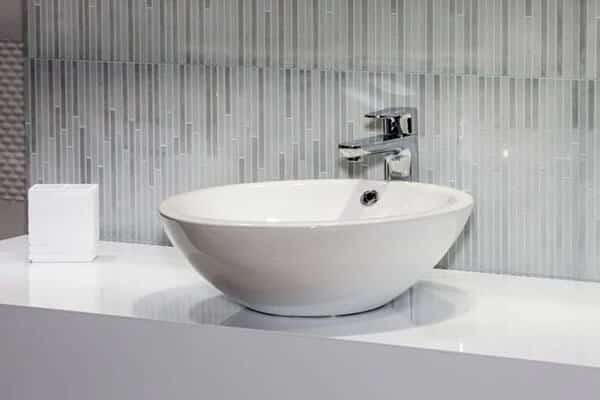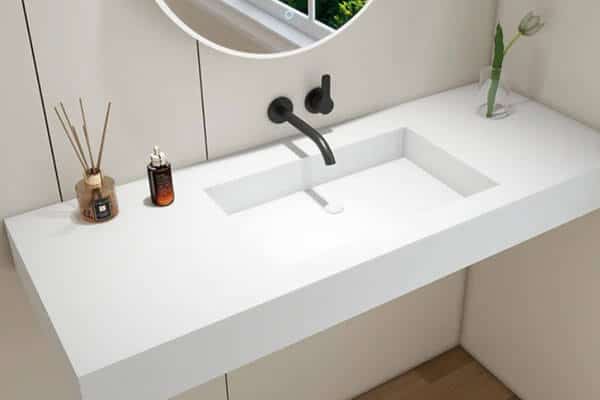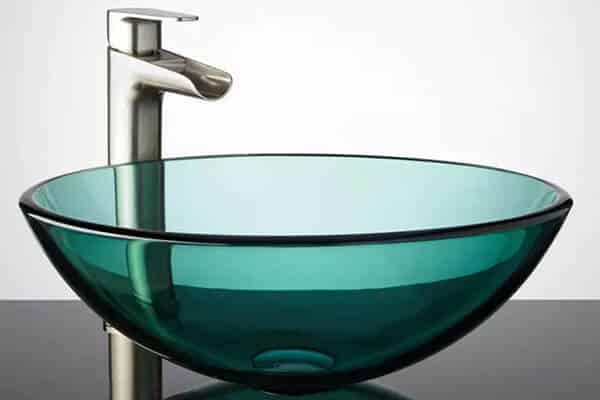When considering remodeling your bathroom, you’ll encounter numerous options for bathroom sinks. Wall-mounted sinks provide more design flexibility. For a traditional look, pedestal sinks are a good choice, offering elegance without taking up too much space. In contemporary remodels, vessel sinks placed on the counter are a popular choice.
Discover the 18 most popular types of bathroom sinks and their main materials in this article. This will aid in selecting the perfect sink to complement your bathroom's style.
Different Types of Bathroom Sinks
Discover 18 primary styles of bathroom sinks with detailed information, including their advantages and disadvantages. Use this as a reference when choosing the perfect fit. We also offer suggestions for the ideal bathroom type or situation.
For your convenience, we offer a variety of vessel/bowl and countertop basins.
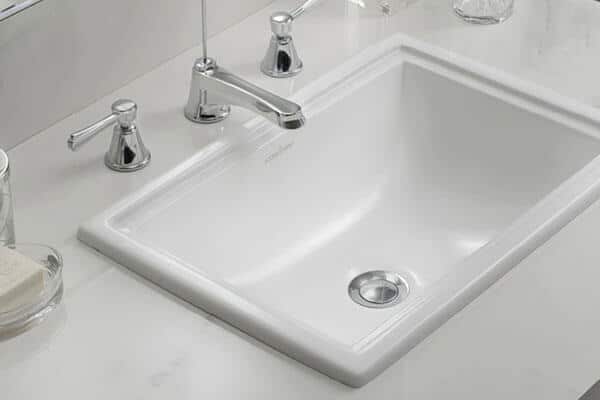 A vessel sink, also called a bowl sink or countertop basin, sits on top of the counter or vanity, making a bold statement in design. They are easy to install but may result in water splashing due to their position above the counter.
A vessel sink, also called a bowl sink or countertop basin, sits on top of the counter or vanity, making a bold statement in design. They are easy to install but may result in water splashing due to their position above the counter.
Pros:
- Modern and stylish appearance
- Material and design variety
- Installs easily
Cons:
- Splashes more easily
- Taller faucets may be required
- Takes up more counter space
Ideal for: Sturdier countertops and statement-making designs make these vanities perfect for master bathrooms and powder rooms. Their ease of use is an added bonus.
Flat or Tabletop Sink
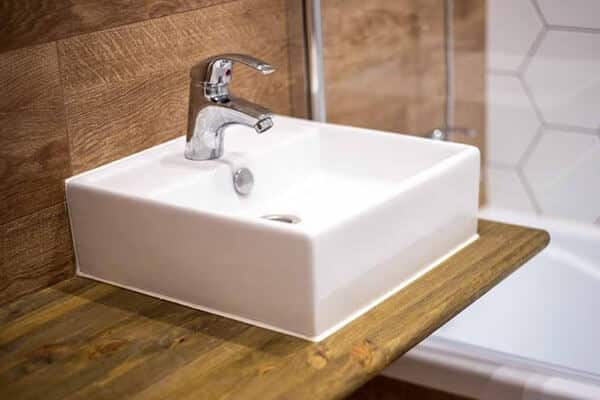 A tabletop sink, also known as a flat sink, rests on top of a bathroom vanity counter like a vessel sink. Unlike vessel sinks, flat sinks have a wide and flat bottom and are commonly rectangular or oval-shaped. They also have a lower height, making them easier for kids to use.
A tabletop sink, also known as a flat sink, rests on top of a bathroom vanity counter like a vessel sink. Unlike vessel sinks, flat sinks have a wide and flat bottom and are commonly rectangular or oval-shaped. They also have a lower height, making them easier for kids to use.
Pros:
- Durable installation due to its wide and flat bottom.
- Modern, sleek design
- Children can use it more easily
Cons:
- The counter may be splashed with water
- Smaller depth than other sinks
Best for: Sleek and modern bathrooms with a contemporary aesthetic, providing plenty of counter space for the sink's design.
Consider using Inset Basins, including Drop-In Basins and Flush Mount Basins.
The drop-in basin falls under the inset basins category and is a sink that fits into a pre-cut hole in the countertop with the rim of the sink resting on top. Unlike drop-in basins, flush mount basins are seamlessly integrated into the countertop.
Pros:
-
Easy to install and replace
-
Compatible with various countertop materials
-
Wide availability in styles and materials
Cons:
-
Rim can collect dirt and grime
-
May look dated in modern bathroom designs
Best for: Discover traditional and elegant master bathrooms with a classic aesthetic.
Undermount, Under-Counter, or Countersunk Basins
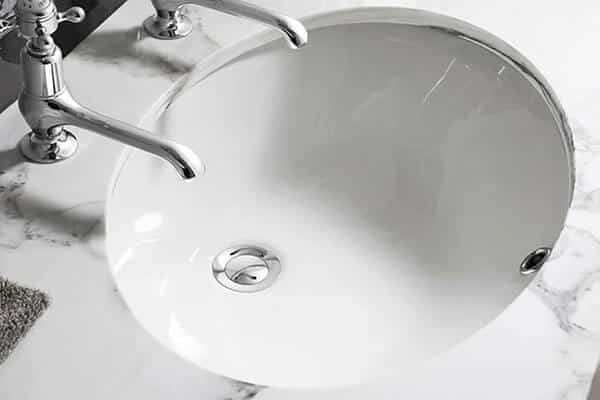
An undermount basin is an example of an inset basin and is mounted below the countertop, resulting in a smooth and seamless appearance. These sinks make cleaning easier as they eliminate an exposed rim and provide a sleek look that improves both beauty and cleanliness.
Pros:
-
Easy to clean with no exposed rim
-
Sleek, modern appearance
-
Maximizes counter space
Cons:
-
Typically more expensive to install
-
Requires waterproof countertop materials
Best for: This product is perfect for smaller or busy family bathrooms, as it features an easy-to-clean design and provides additional counter space. It's a great solution for those who want a more modern bathroom without sacrificing functionality.
Semi Inset Basins
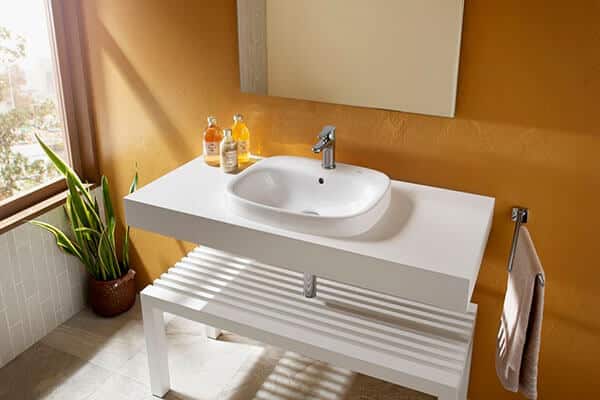
The semi-inset basin is placed partially into the countertop, which maximizes space while still allowing for a taller vanity height and ample storage.
Pros:
-
Saves space without sacrificing bowl size
-
Modern look with practical design
-
Versatile placement options
Cons:
-
May require specific cabinetry or countertop design
-
Installation can be more complex
Best for: The bathrooms, although lacking counter space, still need a full-sized basin.
Semi Recessed Basins
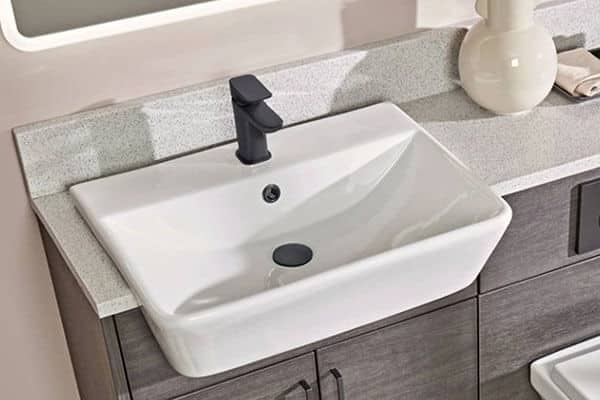
A semi-recessed basin is a sink that is partially recessed into the countertop, with the front of the basin hanging over the edge. This type of sink is perfect for bathrooms with limited countertop space.
Pros:
-
Ideal for narrow countertops
-
Provides more bowl space
-
Contemporary design
Cons:
-
Partial exposure may not suit all bathroom styles
-
Installation may be more involved
Best for: Maximizing the available space is crucial, especially in smaller areas like children's bathrooms.
Wall Hung & Wall Mounted Basins

Wall-mounted basins save floor space and make cleaning easier, setting them apart from wall-hung basins that may require additional support.
Pros:
-
Frees up floor space
-
Accessible design for wheelchairs
-
Easy to clean around
Cons:
-
Plumbing is often exposed
-
May require wall reinforcement
Best for:The description should feel approachable, casual, helpful, and friendly.
Pedestal Sinks
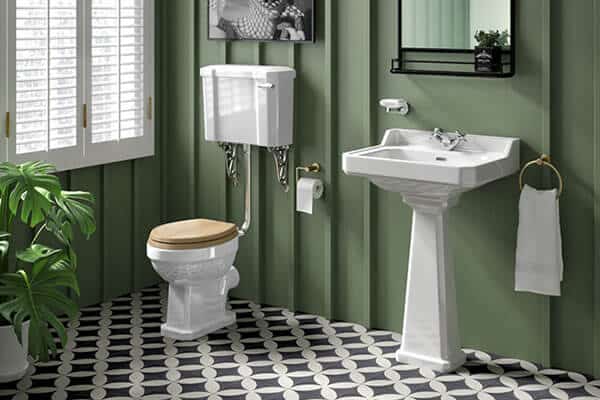
A pedestal sink is a freestanding sink with a single pedestal leg for support, concealing the plumbing and enhancing the overall appearance.
Pros:
-
Classic and elegant design
-
Variety of styles and materials
-
Can fit into tight spaces
Cons:
-
No storage space
-
Plumbing can be tricky to install
Best for: For bathrooms and homes with a vintage aesthetic, this sink's traditional charm is an excellent addition.
Washstands & Console Basins
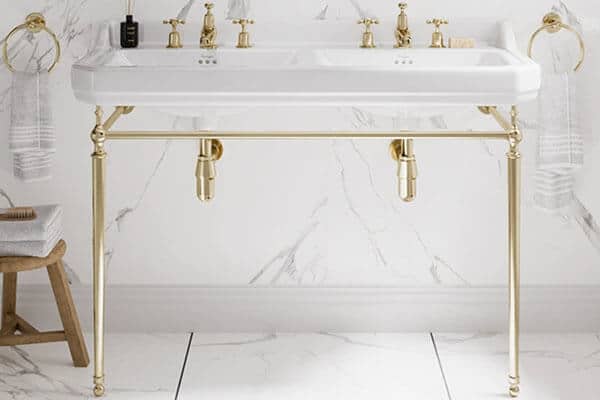
Elevating historical charm, console basins and washstands now cater to modern bathroom necessities while seamlessly blending style and practicality. In a Victorian bathroom, a console basin can be accompanied by contemporary fixtures, creating a beautiful harmony of past and present aesthetics.
Pros:
-
Adds character to the bathroom
-
Open design can make space feel larger
-
Often includes towel rails
Cons:
-
Limited storage options
-
Plumbing may be visible
Best for:Enhance the charm and maintain an open atmosphere in industrial spaces or small bathrooms with the help of these instructions.
Trough Sinks
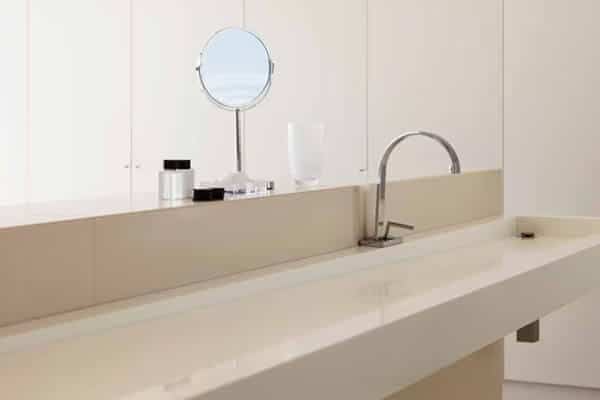
A trough sink is a lengthy and slender sink, inspired by classic horse troughs. Trough sinks can hold multiple faucets and are perfect for busy locations, making usage simple. For example, a public restroom can be revamped with the communal charm and functionality of a trough sink.
Pros:
-
Ideal for multiple users
-
Contemporary and stylish
-
Can replace multiple sinks
Cons:
-
May require a larger space
-
More expensive than standard sinks
Best for: Contemporary bathrooms often have a shared sink, making spaces more functional for everyone, including Jack and Jill.
Vanity Sinks

A vanity sink is usually integrated into a cabinet or table-style vanity with ample storage below.
Pros:
- Combines sink with storage
- Can be a focal point of the bathroom
- Wide variety of design options
Cons:
- Can be more expensive
- May take up more space
- Best for: Bathrooms with plenty of storage and a stylish sink as the centerpiece.
Corner Sinks
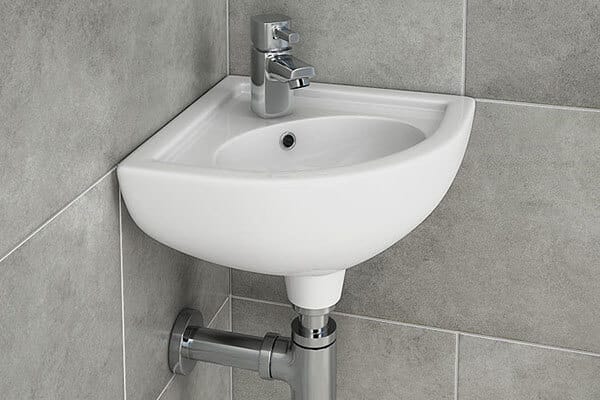
A corner sink perfectly fits into a bathroom corner, maximizing the small space available in compact bathrooms.
Pros:
-
Maximizes unused corner space
-
Ideal for small bathrooms
-
Can have a unique design
Cons:
-
May have limited counter space
-
Can be challenging to find the right fit
Best for: Optimizing compact areas, like powder rooms or guest bathrooms with minimal space.
Washplane Sinks
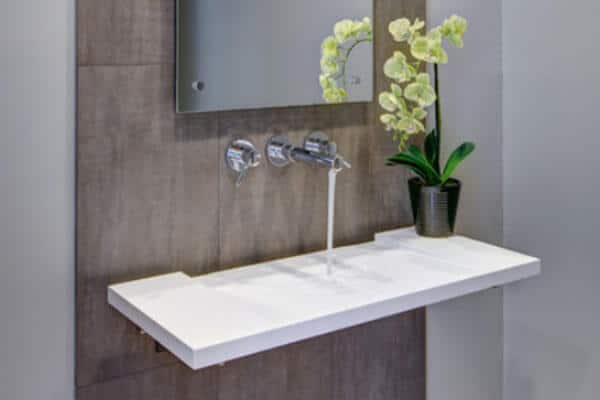
Experience a sleek and modern design with our washplane sinks. Easy maintenance and cleaning make them a top choice, as seen in luxurious hotel bathrooms.
Pros:
-
Sleek and modern design
-
Ideal for low-traffic areas
-
Easy to clean surface
Cons:
-
Prone to splashing
-
Limited bowl depth
Best for: For guest bathrooms and powder rooms, a chic and simplistic sink can elevate the overall look and feel of the space.
Cloakroom Basins
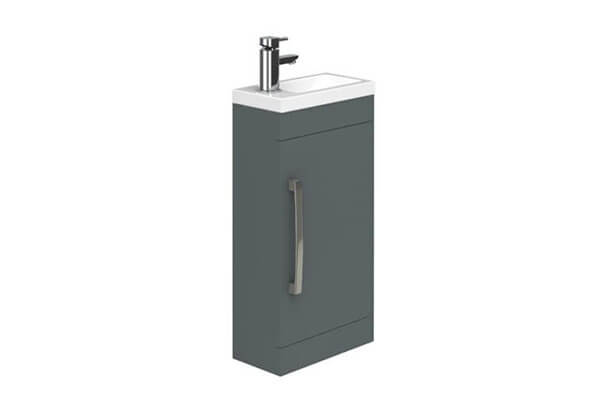
A cloakroom basin is a perfect fit for tight spaces, with a slim design and shorter depth, making it ideal for powder rooms and cloakrooms.
Pros:
-
Space-saving design
-
Can be wall-mounted or corner-installed
-
Suitable for tight spaces
Cons:
-
Limited bowl size
-
May not be suitable for high usage
Best for:
Make the most out of smaller spaces such as cloakrooms and en-suites by utilizing space-saving techniques.
Freestanding Basins
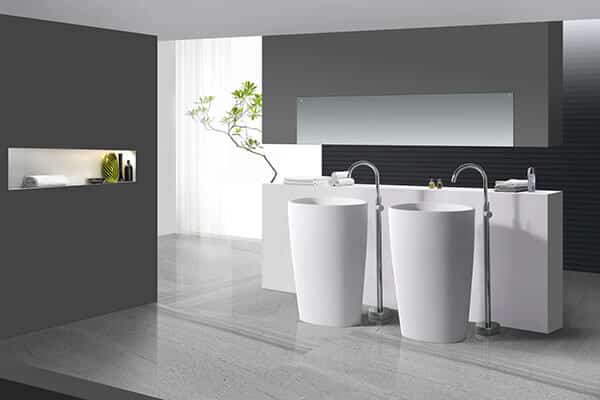
A freestanding basin is a sink that stands on its own, not attached to a wall or countertop. It can make a bold impact and add character to any space. In a boutique hotel lobby, a freestanding basin can create a unique and welcoming atmosphere.
Pros:
- Design that is unique and eye-catching
- It can be placed anywhere in the bathroom
- Styles and materials to choose from
Cons:
- Plumbing may be required
- Can be more expensive
- Best for: Bathrooms with large sinks or spaces where the sink serves as a focal point.
Double Basins

This product includes a double basin with two sinks in one unit, making it perfect for shared bathrooms and providing convenience for multiple users.
Pros:
-
Ideal for shared bathrooms
-
Doubles the functionality
-
Can streamline morning routines
Cons:
-
Requires more space
-
Can be more costly
Best for: Master and family bathrooms require multiple people to use the sink at the same time.
ADA Compliant Sinks
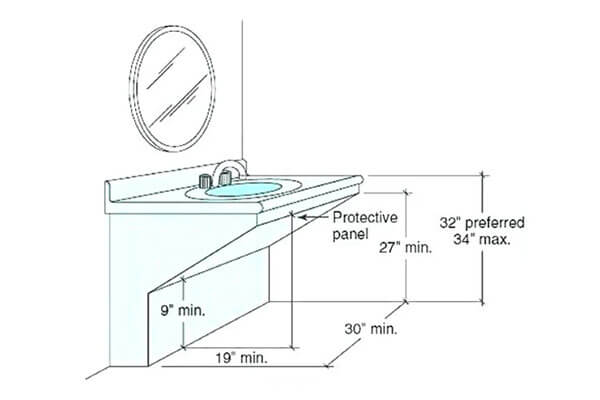
Improve accessibility in public spaces, especially for wheelchair users, with an ADA-compliant sink that meets all Americans with Disabilities Act standards.
Pros:
-
Accessible for individuals with disabilities
-
Meets legal requirements for public spaces
-
Often includes features like lower height and knee clearance
Cons:
-
May have specific design requirements
-
Can be more expensive to install
Best for: For individuals with mobility limitations, both public restrooms and private bathrooms must be equipped to meet their needs.
Bathroom Sink Sizes
When planning a bathroom remodel, it's important to consider the size of the sink. Unsure of what size basin you need? We can offer some guidance.
Sinks come in various sizes, typically ranging from 16 to 20 inches in width.
For example, Rectangular and Oval Sinks:
-
Small: Length ranges from 15 to 20 inches and width varies from 9 to 12 inches.
-
Medium:These measurements typically range from 20 to 30 inches in length and 19 to 24 inches in width.
-
Large:This product is designed to fit any space with its adjustable length of 30 to 50 inches and a consistent width of 19 to 24 inches.
When selecting a sink that complements your bathroom, begin by measuring the counter space you have. Make sure you have a clear idea of the length, width, and depth available on your vanity.
You can choose from various popular vanity sizes such as 24, 30, 36, 48 inches for single-sink vanities, and 60 to 72 inches for double-sink options. The standard size of vanities typically have a depth of around 21 inches and a height between 32 and 36 inches.
Additionally, when considering replacing the current basin, be sure to select a size that fits the allotted space, plumbing tubes, and tap holes.
Bathroom Sink Materials
Consider the materials when selecting a bathroom sink. There are various options, including ceramic and porcelain sinks as well as unique materials like resin or solid surfaces.
Here, we'll go over the most common materials and explain each one in detail.
Clay-Based Ceramic Material: Porcelain, Fire Clay, Vitreous China
Discover various shapes of bathroom sinks, such as round, oval, rectangular, square, and U-shaped, to find the perfect fit for your needs.
Round and Oval Sinks: Round and oval sinks are often praised for their timeless and adaptable style. They offer a smooth and elegant option to balance out any sharp edges in your bathroom, while also being spacious enough for handwashing.
Square Sinks:
For a touch of modernity, consider square sinks with their clean lines and sharp edges. These sinks are perfect for minimalist or contemporary bathroom designs, but may need some extra attention when cleaning around the edges due to their defined shape.
Rectangular Sinks: Rectangular sinks are becoming more popular as they have a larger width, making them ideal for busy bathrooms. The elongated shape also adds a touch of modern elegance and creates additional usable space in the basin.
Bathroom Sink Finishes
Add color and artistic patterns to your basins by choosing ceramic sinks with glazed or vitreous china enamel coating instead of the typical white glossy finish.
Enhance the artistic feel of your bathroom with textured natural stone basins or choose a stylish sheen with silver, copper, and bronze metal sinks.
Selecting the appropriate finish for your bathroom design can have a considerable impact on your home.
Bathroom Sink Styles
Explore a variety of designs, from sleek modern to intricate traditional and antique styles, each with unique features to suit your personal tastes and bathroom decor.
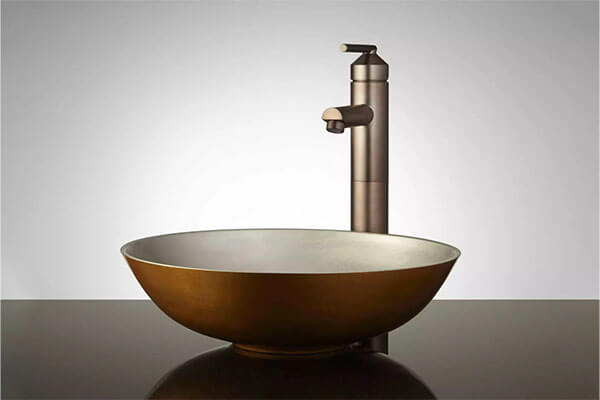
Modern Sinks
Revamp your bathroom with modern sinks, which boast a sleek and sophisticated design through the use of clear glass and polished metal. These elegant sinks are perfect for achieving a chic, contemporary look.
Transform your bathroom into a modern sanctuary with these ideal sinks. The goal is to create an open and uncluttered space, perfect for your needs.
Traditional Sinks
Featuring timeless design elements like sculpted shapes and decorative accents, traditional sinks are usually supported by legs or designed for countertop placement, adding a touch of classic charm to your bathroom.
They excel in creating spaces that capture the charm and warmth of past eras, while complementing the classic aesthetics with their rich heritage look.
Antique Sinks
Antique sinks offer a touch of history, showcasing distinctive designs that can make your bathroom stand out. But it's important to keep in mind their upkeep requirements and how well they work with modern plumbing.
You can source authentic antique sinks from specialty antique stores or salvage shops where you might find a statement piece with a storied past.
Things to Keep in Mind When Choosing a New Bathroom Sink
When shopping for a bathroom sink, make sure to also consider the size, shape, material, finish, style, and color options. Additionally, keep in mind factors such as faucet hole placement, water conservation, and the number of sinks needed. Let's discuss each of these aspects below.
Faucet Holes
Ensure compatibility between your chosen sink and current faucet to avoid any installation problems.
Water Conservation
Select water-efficient sinks and faucets with low-flow rate options and eco-friendly certifications like WaterSense to maximize your water efficiency and support environmental conservation. You'll not only save on utility bills, but also make a positive impact on the environment.
Number of Sinks
When deciding on a sink for your bathroom, consider whether a single or double option is best. Double sinks are great for shared spaces, while single sinks are more space-efficient for smaller areas. Take into account who will be using the bathroom and the amount of space available before making a decision.To learn more about Led Framed mirror, visit:
 Shanghai Divas Glass Co.,Ltd
Shanghai Divas Glass Co.,Ltd

